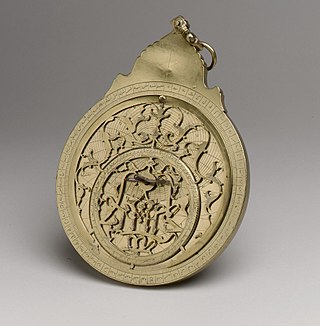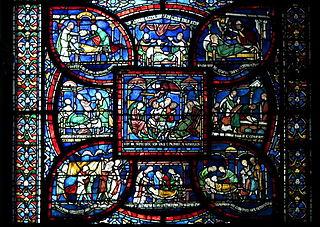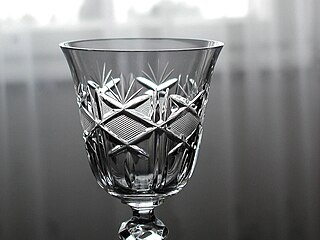
Brass is an alloy of copper (Cu) and zinc (Zn), in proportions which can be varied to achieve different colours and mechanical, electrical, and chemical properties, but copper typically has the larger proportion. In use since prehistoric times, it is a substitutional alloy: atoms of the two constituents may replace each other within the same crystal structure.

A box camera is a simple type of camera, the most common form being a cardboard or plastic box with a lens in one end and film at the other. They were sold in large numbers during the late 19th and early 20th centuries. The lenses are often single element designs meniscus fixed focus lens, or in better quality box cameras a doublet lens with minimal possible adjustments to the aperture or shutter speeds. Because of the inability to adjust focus, the small lens aperture and the low sensitivity of the sensitive materials available, these cameras work best in brightly lit day-lit scenes when the subject is within the hyperfocal distance for the lens and of subjects that move little during the exposure. Eventually, box cameras with photographic flash, shutter and aperture adjustment were introduced, allowing indoor photos.

A chandelier is a branched ornamental light fixture designed to be mounted on ceilings or walls. Chandeliers are often ornate, and normally use incandescent light bulbs, though some modern designs also use fluorescent lamps and recently LEDs.

A baluster is an upright support, often a vertical moulded shaft, square, or lathe-turned form found in stairways, parapets, and other architectural features. In furniture construction it is known as a spindle. Common materials used in its construction are wood, stone, and less frequently metal and ceramic. A group of balusters supporting a handrail, coping, or ornamental detail are known as a balustrade.

Came glasswork is the process of joining cut pieces of art glass through the use of came strips or foil into picturesque designs in a framework of soldered metal.

Glass disease, also referred to as sick glass or glass illness, is a degradation process of glass that can result in weeping, crizzling, spalling, cracking and fragmentation. Glass disease is caused by an inherent instability in the chemical composition of the original glass formula. Properties of a particular glass will vary with the type and proportions of silica, alkali and alkaline earth in its composition. Once damage has occurred it is irreversible, but decay processes can be slowed by climate control to regulate surrounding temperature, humidity, and air flow.

Altar candles are candles set on or near altars for religious ceremonies. Various religions have regulations or traditions regarding the number and type of candles used, and when they are lit or extinguished, for example during the liturgies.
Skultuna Messingsbruk is a Swedish manufacturer of brass and brass products. Founded in 1607 at the behest of King Karl IX, Skultuna Messingsbruk is located in Skultuna on the outskirts of Västerås. The logotype of Skultuna consists of the closed royal crown, the name "Skultuna" and the founding year "1607".

The conservation and restoration of parchment constitutes the care and treatment of parchment materials which have cultural and historical significance. Typically undertaken by professional book and document conservators, this process can include preventive measures which protect against future deterioration as well as specific treatments to alleviate changes already caused by agents of deterioration.

St John the Evangelist's Church is a redundant Anglican church in the centre of the city of Leeds, West Yorkshire, England. It is recorded in the National Heritage List for England as a designated Grade I listed building, and is under the care of the Churches Conservation Trust. The architectural historian Nikolaus Pevsner refers to it as "the only church at Leeds of more than local interest".

The College Club of Boston is a private membership organization founded in 1890 as the first women's college club in the United States. Located in the historic Back Bay of Boston, Massachusetts at 44 Commonwealth Avenue, the College Club was established by nineteen college educated women whose mission was to form a social club where they and other like-minded women could meet and share companionship.
Conservation and restoration of movable cultural property is a term used to denote the conservation of movable cultural property items in libraries, archives, museums and private collections. Conservation encompasses all the actions taken toward the long-term preservation of cultural heritage. Activities include examination, documentation, treatment, and preventive care, which is supported by research and education. Object conservation is specifically the actions taken to preserve and restore cultural objects. The objects span a wide range of materials from a variety of cultures, time periods, and functions. Object conservation can be applied to both art objects and artifacts. Conservation practice aims to prevent damage from occurring, a process known as 'preventive conservation'. The purpose of preventive conservation is to maintain, and where possible enhance, the condition of an object, as well as managing deterioration risks, such as handling and environmental conditions. Historically, object conservation was focused on the category of fine arts but now many different types of objects are conserved. Each type of object material, typically denoted by organic or inorganic then the specific medium, requires a specialized professional conservator and often requires collaborative work between museum staff, scientists, and conservators.

The conservation and restoration of silver objects is an activity dedicated to the preservation and protection of objects of historical and personal value made from silver. When applied to cultural heritage this activity is generally undertaken by a conservator-restorer.

Art in bronze and brass dates from remote antiquity. These important metals are alloys, bronze composed of copper and tin and brass of copper and zinc.

The Hezilo chandelier is an 11th-century Romanesque wheel chandelier. It is part of the treasures of the Hildesheim Cathedral in Hildesheim, Germany, which has been a UNESCO World Cultural Heritage site since 1985. The chandelier was most likely commissioned by Bishop Hezilo of Hildesheim, who rebuilt the cathedral after a fire. He probably also influenced the program of imagery and inscriptions. It is the largest of four extant wheel chandeliers of the period; the others surviving examples are the Azelin chandelier, the Barbarossa chandelier in the Aachen Cathedral, and the Hartwig chandelier in the Abbey of Comburg.

The conservation and restoration of shipwreck artifacts is the process of caring for cultural heritage that has been part of a shipwreck. Oftentimes these cultural artifacts have been underwater for a great length of time. Without conservation, most artifacts would perish and important historical data would be lost. In archaeological terms, it is usually the responsibility of an archaeologist and conservator to ensure that material recovered from a shipwreck is properly cared for. The conservation phase is often time-consuming and expensive, which is one of the most important considerations when planning and implementing any action involving the recovery of artifacts from a shipwreck.
The hogscraper candlestick is an early form of lighting device commonly used in 19th-century North America and Britain, and mainly manufactured in England. The device is manufactured of tempered sheet iron, wrought in several pieces and joined by metal joinery and silver soldering. The name is derived from the candlesticks resemblance to an antique device used to scrape bristles from hog hide after slaughter. The antique lighting device commonly consists of a shaft, attached to a round base with a thumb tab ejector mechanism to remove the residual candle stub, and a round lip or "bobèche" to collect candle drippings. The "bobèche" often has a hook extension used for hanging the device.

The conservation and restoration of lighthouses is when lighthouse structures are preserved through detailed examination, cleaning, and in-kind replacement of materials. Given the wide variety of materials used to construct lighthouses, a variety of techniques and considerations are required. Lighthouses alert seagoers of rocky shores nearby and provide landmark navigation. They also act as a physical representation to maritime history and advancement. These historic buildings are prone to deterioration due to their location on rocky outcrops of land near the water, as well as severe weather events, and the continued rise of sea levels. Given these conditions preservation and conservation efforts have increased.

The conservation and restoration of photographic plates is the process of caring for and maintaining photographic plates in order to preserve their materials and content. It covers the necessary measures that can be taken by conservators, curators, collection managers, and other professionals to conserve the material unique to photographic plate processes. This practice includes understanding the composition and agents of deterioration of photographic plates, as well as the preventive conservation and interventive conservation measures that can be taken to increase their longevity.

Cut glass or cut-glass is a technique and a style of decorating glass. For some time the style has often been produced by other techniques such as the use of moulding, but the original technique of cutting glass on an abrasive wheel is still used in luxury products. On glassware vessels, the style typically consists of furrowed faces at angles to each other in complicated patterns, while for lighting fixtures, the style consists of flat or curved facets on small hanging pieces, often all over. Historically, cut glass was shaped using "coldwork" techniques of grinding or drilling, applied as a secondary stage to a piece of glass made by conventional processes such as glassblowing.

















